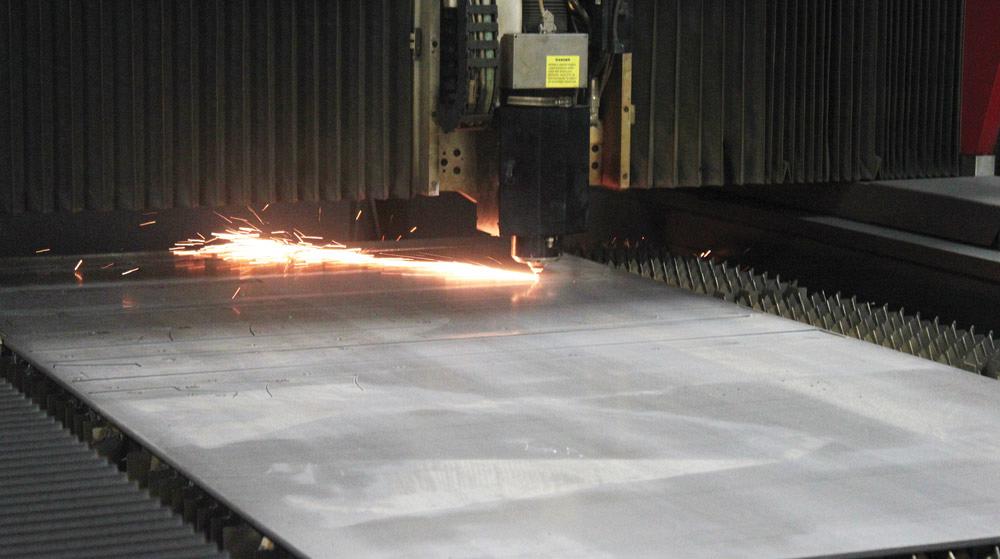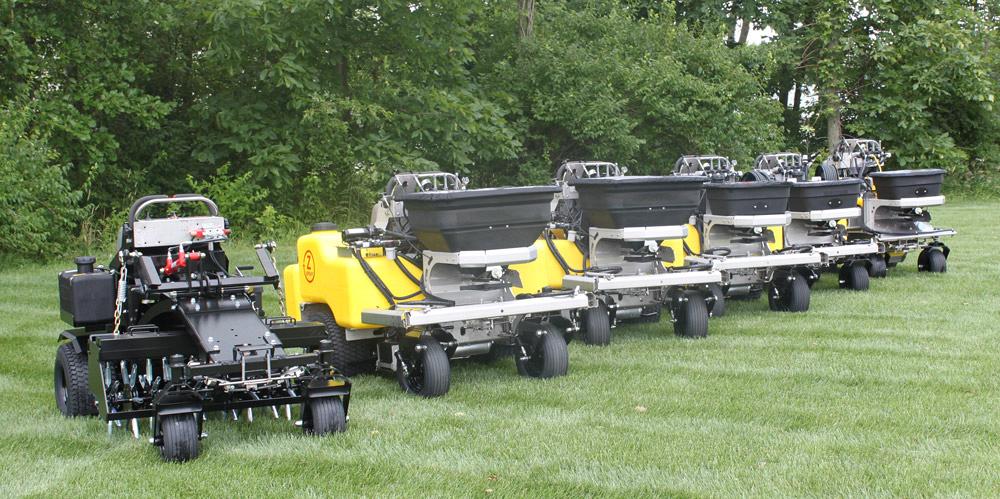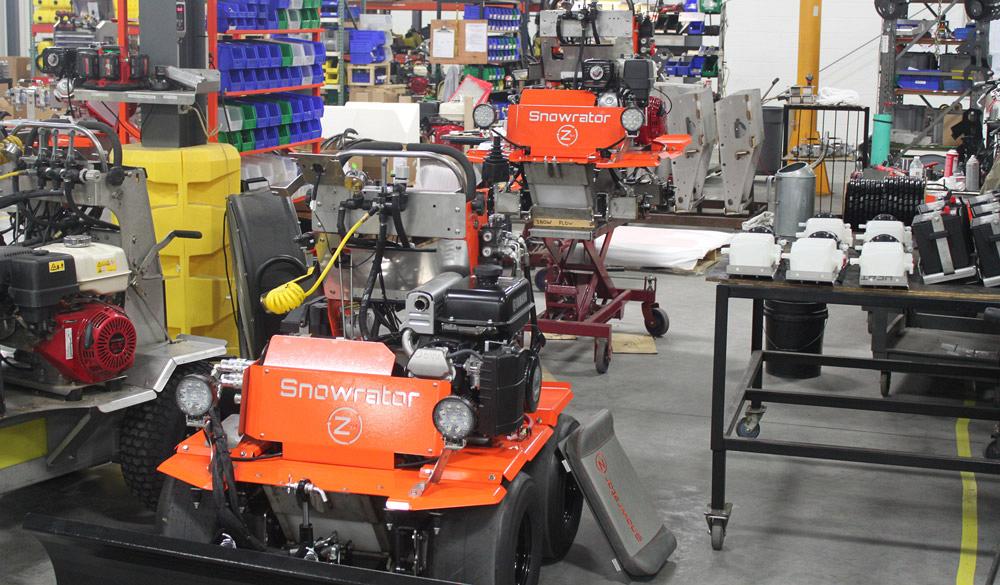Senior Editor
- FMA
- The Fabricator
- FABTECH
- Canadian Metalworking
Categories
- Additive Manufacturing
- Aluminum Welding
- Arc Welding
- Assembly and Joining
- Automation and Robotics
- Bending and Forming
- Consumables
- Cutting and Weld Prep
- Electric Vehicles
- En Español
- Finishing
- Hydroforming
- Laser Cutting
- Laser Welding
- Machining
- Manufacturing Software
- Materials Handling
- Metals/Materials
- Oxyfuel Cutting
- Plasma Cutting
- Power Tools
- Punching and Other Holemaking
- Roll Forming
- Safety
- Sawing
- Shearing
- Shop Management
- Testing and Measuring
- Tube and Pipe Fabrication
- Tube and Pipe Production
- Waterjet Cutting
Industry Directory
Webcasts
Podcasts
FAB 40
Advertise
Subscribe
Account Login
Search
Lean manufacturing prepares lawn care OEM for the future
Lawn care OEM launches a lean initiative and prepares for the future
- By Tim Heston
- February 10, 2016
- Article
- Shop Management

Figure 1
A line of commercial lawn sprayers are assembled at L.T. Rich Products’ plant outside Indianapolis. In its prior facility, products were batch-fabricated and batch-assembled. Today batch sizes have been reduced dramatically.
Tom Rich knows what it’s like to own a commercial lawn care company. He ran one himself in the 1990s. He knows about the long hours, and he knows what makes those hours so long. Spring is fertilizing season, and for commercial lawn care companies managing acres and acres of grass, the labor hours can skyrocket.
In the late 1990s Rich had the idea to build a ride-along sprayer system powerful enough for a worker to cover a lot of acreage in short order, yet small enough so it could be maneuvered into the nooks and crannies of manicured landscapes. From this idea sprang Lebanon, Ind.-based L.T. Rich Products, which Rich launched 16 years ago out of his garage.
During its early days the company outsourced all fabrication and only assembled in-house. If the firm followed the traditional growth path of niche lawn care equipment production, it probably would have remained strictly an assembler. But L.T. Rich Products isn’t a typical commercial lawn care OEM.
Going Direct
Through most of its history, the company has sold directly to customers—that is, the owners and managers of commercial lawn care companies—circumventing the distributor and dealer network. This, Rich said, has given his company a direct path of communication to customers.
Through conversations at tradeshows and elsewhere, Rich and his engineers have talked with customers about what they want in their products that would make their jobs easier. Years ago one new product included a ride-along aerator machine. Commercial lawn services often use tractor attachments to aerate lawns, but aerating acres this way ties up a tractor for a long time. Whence came L.T. Rich’s aerator line, which also comes with attachments like a fertilizer sprayer and snow plow, giving the product year-round use.
If Rich or his engineers talk with customers at a tradeshow, they may come up with an idea or product option on the ride home. Within days they adapt a new product design and send it to engineering, prototyping, and testing—and bam!, they’re producing a new product. The OEM also customizes equipment based on customer requests.
All this makes for a fast-changing operation, and it also makes it difficult to coordinate with a network of suppliers. “So with our initial growth in the [early] 2000s, we brought everything we could in-house, from laser cutting the stainless steel to shipping our product out the door,” Rich said. “We change designs on-the-fly, build it, and test it. It’s not the cheapest way to do it, and it’s actually a riskier way to do it. But in the end it affords us so much versatility. We can dream up whatever we want and then build it.”
Rich isn’t one for meetings or bureaucracy, and his company lacked both during the early days. Because its products were big hits, the company grew by double digits during the early 2000s.
Then in 2012 the company struck a deal with John Deere Landscapes (which has since changed its name to SiteOne Landscape Supply) to sell its sprayers and aerators through its more than 450 branches nationwide. Sales skyrocketed, jumping 40 percent in 2012 and another 40 percent in 2013. Rich’s people just couldn’t design and build machines fast enough.
“In our old facility, we didn’t utilize an assembly line,” Rich said. “We batch-cut and batch-assembled them. We were constantly losing stuff, constantly overproducing stuff, and our batch sizes were way out of whack.”

Figure 2
All the parts of a certain gauge and grade for a batch of six units are cut on the laser. The company recently installed its second laser and, as of early January, had plans to install an automated material handling tower.
All that batching created a lot of work-in-process (WIP) and tied up a lot of cash, especially considering the kind of sheet metal the company processes. Spray fertilizer is very corrosive, so about 90 percent of the metal on these machines needs to be stainless steel.
Despite the chaotic nature of design and production and despite the excessive WIP, Rich said that the company remained debt-free and in good shape financially. Still, he saw the writing on the wall.
Lead times for some machines stretched out eight to 12 weeks. Rich knew what it was like to run a lawn care company. “If it’s spring and the weeds are popping up, eight to 12 weeks is just not acceptable.”
He knew things had to change, but how? Then in 2013 he visited a Douglas Dynamics plant in Wisconsin. The large company is known for, among other products, its FISHER® snow plows. The FISHER product dominates the U.S. truck plow business, a sector with extraordinarily stringent delivery demands.
“They’ve got it even worse than we do,” Rich said. “When you need a plow, you need a plow today.
“To increase profits, [Douglas Dynamics] had to do it internally, because there wasn’t a whole lot the company could do marketwise,” Rich continued. “When I visited, people at the plant had lean manufacturing down to an absolute science.”
Besides 5S, visual management, and other lean tools, the Douglas Dynamics plant borrowed ideas from the theory of constraints. At the plant’s center was powder coating, the constraint process that set the pace for throughput. The company’s lasers, press brakes, and other machines were all paced around powder coating. “There was a purpose behind everything they were doing,” Rich said.
Driving home to Indiana, Rich knew that eight to 12 weeks of lead time was just too long. A two-week lead time would be ideal, but things needed to change. It was a good time to make changes, considering Rich’s company was just about to move into a newly built facility. The only question left was, where to start?
Launching Into Lean
“Before, the mentality was, ‘We need to keep the machines running. We need to continue welding and grinding and making sparks. If we cut batch sizes, we won’t be making as much and won’t be doing it as fast.’ Regardless, I said, ‘Let’s cut the batch sizes in half.’ They looked at me as if I had three eyes and four heads. But they went along with it. And then we cut them again. Now batch sizes are small, but it creates a part flow velocity that allows them to be more responsive to customers, and have less WIP.”
So said Jeff Sipes, principal at Back2Basics LLC, a lean consultancy in Indianapolis that has worked with L.T. Rich Products for about two years. When Sipes arrived, he initiated basic 5S, flow, and visual management.
Soon after he dove into batch sizes (see Figure 1). At the time the laser, press brake, and robot welding cells produced batches of parts for 16 units, on average. So if each sprayer needs two panels, 32 panels (2×16) would be nested on the laser. Now the fabrication department produces enough parts for about six units.
As Sipes explained, the operation is in one sense a hybrid of batch and kit part flow. Technicians program the laser so that most flat parts of the same gauge for the batch are cut. This ensures certain components can move on to subsequent forming and welding as soon as possible (see Figures 2 and 3).
At the same time the laser operator also sometimes processes a nest of tiny parts common to most product lines.
This may be enough parts for several months’ worth of products, but cutting ahead and storing the inventory just makes sense. If these small parts were nested with the larger parts, they could easily get lost in the shuffle. A little extra small-part inventory is less expensive than having to recut lost parts time and again.
Press brakes and the welding cells now have tools organized so that operators can change over as quickly as possible. If those changeovers become even faster, the operation may consider making batch sizes even smaller.
For now the batch is large enough so that the machines don’t have an excessive number of setups during the day. The batch is also not so large as to overproduce and flood the floor with WIP. After fabrication, carbon steel parts (and a few stainless parts, for reasons described later) are sent to a nearby custom powder coater, which turns products around quickly.
From here parts go to a staging area adjacent to the company’s two assembly lines, one dedicated to sprayers and another dedicated to aerators (see Figure 4) and a new product—snow plows (see Figure 5).
A Seasonal Business
To develop its new snow plow line, the people at L.T. Rich put themselves in customers’ shoes. Many lawn care customers run snow plow operations in the winter, and a time-consuming part of that is removing snow from sidewalks and walkways.
L.T. Rich’s small plow machine fills this need. The company already had experience building similarly designed products. Press brake operators had even made plows before, bump-bending the stainless steel sheet. A plow attachment to the aerator line had been available for years. (Interestingly, the stainless plows are powder-coated orange, just because the orange is more visible in snow.) And the machines, as with other products the company produces, are built with modular components that simplify fabrication and planning. This new product also happens to have an opposite demand cycle than that of the sprayer and aerator.
Still, at this writing, the snow plow is a new product, and there’s no getting around a fact of life for any manufacturer serving the lawn care business: It’s seasonal, which makes planning difficult, especially when dealing with purchased parts with long lead times. Engines, for instance, have a 120-day lead time. (Due to the nature of the small-engine market, which must deal with EPA regulations, Rich said his company has limited supplier options.)

Figure 4
LT Rich Products’ manufactures several lines of ride-along sprayers (yellow vehicles on the right) as well as a line of aerators (black vehicle on left).
Rich didn’t want to rely on temporary workers, and he didn’t want to add a second shift, which for Rich has always been difficult to manage because of, among other reasons, the lack of skilled labor.
To remedy the situation, the company made two big changes. First, it changed to a four 10-hour-day workweek. Until recently the only machine that ran more than four days was the laser. (At this writing, the laser cutting operations soon will be running on the same four-day schedule; the company recently installed a second laser, and a material handling tower is being installed early this year.)
The four-day schedule not only makes the company attractive to work for—people like three-day weekends—but it also gives the operation some flexibility. If workers need to do overtime, they don’t need to stay at the factory late; they just come in on Friday.
Second, the company instituted sales and operations planning (S&OP), using customer intelligence and other data to better predict demand. This in turn has allowed L.T. Rich to level-load its production schedule.
“Because our goal is to have a customer lead time of no more than two weeks, we needed to consider level-loading our production,” Rich said. “We now have a lot more structure in our forecasting. Don’t get me wrong; it’s not cheap, because you’re building a lot more inventory, but it’s really the only way you can get through those peaks and valleys of demand. It’s been huge in helping us figure out what we’re building, when we’re building it, and how much inventory we’re going to hold.”
As Sipes explained, “Level-loading reduces the peaks and raises the valleys, which allows the company to more effectively use its assets and resources throughout the year. Instead of ramping up production to handle the spring rush and winding down through the slow period, the range of daily output is much narrower throughout the year.”
The company sells some during the slow times, but most goes to inventory. Still, that inventory certainly comes in handy during the months with heavy customer demand.
Customers may request certain options, which are added just before shipping. But modifying the products in inventory is a lot easier than scrambling to meet an unmanageable spike in orders.
More Structure, Less Chaos
Tom Rich, the get-it-done entrepreneur who has lived through 40 percent growth for two years running, and who relied on the quick hallway meeting before running in five directions at once to put out the next fire, now has more structure to his workday.
He and his management team hold a 15-minute production meeting every day, just to make sure everybody is on the same page. The engineering change process now is more structured, and new part information flows seamlessly to manufacturing management and the shop floor. And workers now receive job information on tablet computers. When engineering makes a change, new information is uploaded as a PDF to the server, which then distributes those PDFs to tablets.

Figure 5
L.T. Rich’s new snow plow product line shares the same assembly line with its aerator product.
The lean journey isn’t complete (it never is), but it’s well underway. Rich still talks with customers all the time, and he knows their pain. “Health care and other costs are really out of control,” he said. “My customer now has less money and less to work with. We need to look for new business and ways to save labor costs for our customers.”
Rich’s company employed 25 people in 2013; today it has 50. Although the growth may not continue so rapidly, Rich said he does see growth continuing over the next few years. The trick will be to continue developing products that save his customers time and money. And to compete, he knows he needs to go to market as soon as possible. Today the shop has the structure in place to do just that.
Photos courtesy of L.T. Rich Products, 920 Hendricks Drive, Lebanon, IN 46052, 765-482-2040, www.z-spray.com.
Back2Basics LLC, 9250 Eagle Meadow Drive, Indianapolis, IN 46234, 317-439-7960, www.back2basics-lean.com
About the Author

Tim Heston
2135 Point Blvd
Elgin, IL 60123
815-381-1314
Tim Heston, The Fabricator's senior editor, has covered the metal fabrication industry since 1998, starting his career at the American Welding Society's Welding Journal. Since then he has covered the full range of metal fabrication processes, from stamping, bending, and cutting to grinding and polishing. He joined The Fabricator's staff in October 2007.
subscribe now

The Fabricator is North America's leading magazine for the metal forming and fabricating industry. The magazine delivers the news, technical articles, and case histories that enable fabricators to do their jobs more efficiently. The Fabricator has served the industry since 1970.
start your free subscription- Stay connected from anywhere

Easily access valuable industry resources now with full access to the digital edition of The Fabricator.

Easily access valuable industry resources now with full access to the digital edition of The Welder.

Easily access valuable industry resources now with full access to the digital edition of The Tube and Pipe Journal.
- Podcasting
- Podcast:
- The Fabricator Podcast
- Published:
- 04/16/2024
- Running Time:
- 63:29
In this episode of The Fabricator Podcast, Caleb Chamberlain, co-founder and CEO of OSH Cut, discusses his company’s...
- Trending Articles
Capturing, recording equipment inspection data for FMEA

Tips for creating sheet metal tubes with perforations

Are two heads better than one in fiber laser cutting?

Supporting the metal fabricating industry through FMA

Hypertherm Associates implements Rapyuta Robotics AMRs in warehouse

- Industry Events
16th Annual Safety Conference
- April 30 - May 1, 2024
- Elgin,
Pipe and Tube Conference
- May 21 - 22, 2024
- Omaha, NE
World-Class Roll Forming Workshop
- June 5 - 6, 2024
- Louisville, KY
Advanced Laser Application Workshop
- June 25 - 27, 2024
- Novi, MI



























